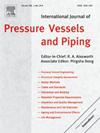基于微区材料测试和机器学习的管道环焊缝本构关系确定方法
IF 3
2区 工程技术
Q2 ENGINEERING, MECHANICAL
International Journal of Pressure Vessels and Piping
Pub Date : 2025-05-30
DOI:10.1016/j.ijpvp.2025.105570
引用次数: 0
摘要
准确获取材料的本构关系是结构设计和安全评价的基本要求。小冲孔试验(SPT)作为一种获取材料窄区域力学性能的测试方法,在表征管道环焊缝力学性能方面具有独特的优势和巨大的潜力。本文以X80管道环焊缝各区域材料为研究对象,结合现场拉伸试验、SPT、有限元(FE)模拟、机器学习(ML)等方法,达到高效确定管道环焊缝各区域材料本构关系的目的。具体而言,通过原位拉伸试验和SPT,获得了X80管道环焊缝各区域材料的真应力-应变曲线和SPT荷载-位移曲线。并用实验数据验证了SPT有限元模型的可靠性。为了建立机器学习数据库,进行了大量的数值模拟工作。最后,建立了具有复杂结构的深度学习模型(DLM),实现了从SPT载荷-位移数据中确定材料真实应力-应变关系的功能。该DLM在有限元模拟数据和实验数据上均表现良好,预测误差小于4.3%。并且具有较快的预测速度,能够有效地预测管道钢材料的本构关系,为现场工程实际应用提供了可能。本文章由计算机程序翻译,如有差异,请以英文原文为准。
An efficient method for determining the constitutive relationships of pipeline girth welded joints based on micro-area material testing and machine learning
Accurately obtaining the constitutive relationships of materials is the fundamental requirement for structural design and safety assessment. The small punch test (SPT), as a testing method for acquiring the mechanical properties of materials in narrow areas, possesses unique advantages and great potential in characterizing the mechanical properties of pipeline girth weld joints. Taking the materials in various regions of X80 pipeline girth weld joints as the research objects, this paper combines in-situ tensile tests, SPT, finite element (FE) simulation, and machine learning (ML) methods to achieve the goal of efficiently determining the constitutive relationship of materials in various regions of pipeline girth weld joints. Specifically, the true stress-strain curves and SPT load-displacement curves of materials in various regions of X80 pipeline girth weld joints are obtained through in-situ tensile tests and SPT. And the reliability of the SPT FE model is verified with the help of experimental data. Many numerical simulation works are carried out to establish a ML database. Finally, a deep learning model (DLM) with a complex structure is established, which can realize the function of determining the true stress-strain relationships of materials from the SPT load-displacement data. This DLM performs well on both FE simulation data and experimental data, with a prediction error lower than 4.3 %. Moreover, it has a relatively fast prediction speed, enabling it to efficiently predict the constitutive relationships of pipeline steel materials and providing the possibility for practical applications in on-site engineering.
求助全文
通过发布文献求助,成功后即可免费获取论文全文。
去求助
来源期刊
CiteScore
5.30
自引率
13.30%
发文量
208
审稿时长
17 months
期刊介绍:
Pressure vessel engineering technology is of importance in many branches of industry. This journal publishes the latest research results and related information on all its associated aspects, with particular emphasis on the structural integrity assessment, maintenance and life extension of pressurised process engineering plants.
The anticipated coverage of the International Journal of Pressure Vessels and Piping ranges from simple mass-produced pressure vessels to large custom-built vessels and tanks. Pressure vessels technology is a developing field, and contributions on the following topics will therefore be welcome:
• Pressure vessel engineering
• Structural integrity assessment
• Design methods
• Codes and standards
• Fabrication and welding
• Materials properties requirements
• Inspection and quality management
• Maintenance and life extension
• Ageing and environmental effects
• Life management
Of particular importance are papers covering aspects of significant practical application which could lead to major improvements in economy, reliability and useful life. While most accepted papers represent the results of original applied research, critical reviews of topical interest by world-leading experts will also appear from time to time.
International Journal of Pressure Vessels and Piping is indispensable reading for engineering professionals involved in the energy, petrochemicals, process plant, transport, aerospace and related industries; for manufacturers of pressure vessels and ancillary equipment; and for academics pursuing research in these areas.

 求助内容:
求助内容: 应助结果提醒方式:
应助结果提醒方式:


